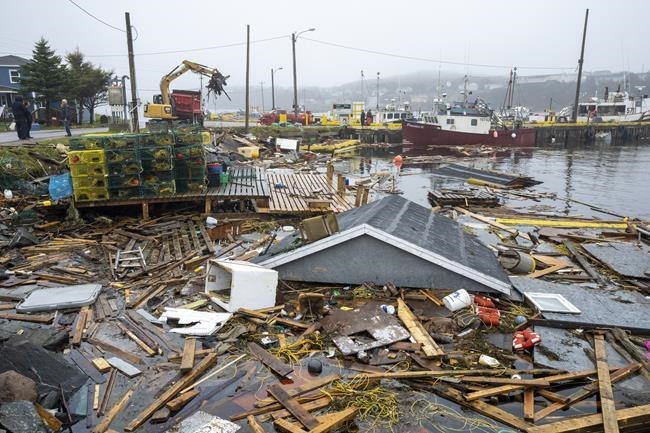Hurricane Fiona caused $660 million in insured damage, according to an initial estimate by Catastrophe Indices and Quantification Inc.
The Insurance Bureau of Canada said Wednesday the storm was the most costly extreme weather event ever recorded in Atlantic Canada in terms of insured damages based on the estimate provided by CatIQ.
IBC added that many of those affected by the storm were located in high-risk flood areas and floodplains where residential flood insurance coverage is not available.
As a result, the bureau said the overwhelming majority of costs for the disaster will be borne by government.
The storm made landfall in Nova Scotia on Sept. 24 and ripped through the region, knocking out power to more than 500,000 customers in the Maritimes. The hurricane caused violent winds exceeding 100 kilometres per hour, torrential rainfall, flooding and downed trees, and resulted in several deaths, the IBC said.
The bureau said the storm also washed at least 20 homes into the ocean, primarily in Port aux Basques, N.L.
More than half of the insured damages were in Nova Scotia, said the IBC, at more than $385 million, with Prince Edward Island following with more than $220 million in insured damages.
The second most expensive extreme weather event in Atlantic Canada was hurricane Juan in 2003, which the IBC said cost $192 million when adjusted for inflation in 2021.
While hurricane Fiona was the most expensive extreme weather event in Atlantic Canada, it was the 10th most expensive natural disaster in Canada as measured by insurance payouts, according to the IBC.
The 2016 Fort McMurray wildfires topped the list at $4 billion when adjusted for inflation.
Five of the 10 most costly natural disasters in Canada happened within the last five years, including the British Columbia flooding in 2021 ($675 million) and the 2020 hailstorm in Alberta ($1.2 billion).
IBC said insurance claims from severe weather events have more than quadrupled across Canada since 2008, with the "new normal" for insured catastrophic damages in Canada at $2 billion a year.
That’s compared to an annual average of $632 million between 2001 and 2010, according to the IBC.
Amanda Dean, IBC's Atlantic vice-president, said Canada needs to improve its resilience to extreme weather events as climate change takes its toll.
"Climate change is real, and the fatalities, emotional turmoil and financial consequences we've witnessed must be a call to action — we must prioritize the protection of all Canadians from the impacts of climate change," said Dean in a news release Wednesday.
Experts have said that hurricane Fiona highlighted the gaps in residential insurance coverage, as much of the damage was not covered.
Residential policies usually require add-ons to cover floods, and even those don’t normally cover storm surge damage.
Possibly the only insurance to cover storm surge damage is offered by The Co-operators Group Ltd., which began offering storm surge insurance to homeowners in Atlantic Canada and British Columbia in 2018.
IBC is a member of the federal, provincial and territorial Task Force on Flood Insurance and Relocation and has been advocating for a national public-private flood insurance program for residents in high-risk areas, the organization said.
“Canada must prioritize its work on a national adaptation strategy, including a high-risk flood insurance pool, to address climate-related disasters such as extreme heat, wildfires, floods, windstorms and hail. Increased collaboration across the public and private sectors is essential to defending Canadians from these events,” said the IBC in the release.
Flood or storm surge insurance, where they’re available, are often quite costly, said Nadja Dreff, senior vice-president of global insurance at DBRS Morningstar.
"The reason why it's more feasible to be some sort of a public-private partnership is because where the risk of flooding is very high, the cost of insurance is also very high," she said.
A public-private model, where the government would take on some of the risk associated with flooding insurance, would help make it more affordable, Dreff said.
This report by The Canadian Press was first published Oct. 19, 2022.
The Canadian Press



